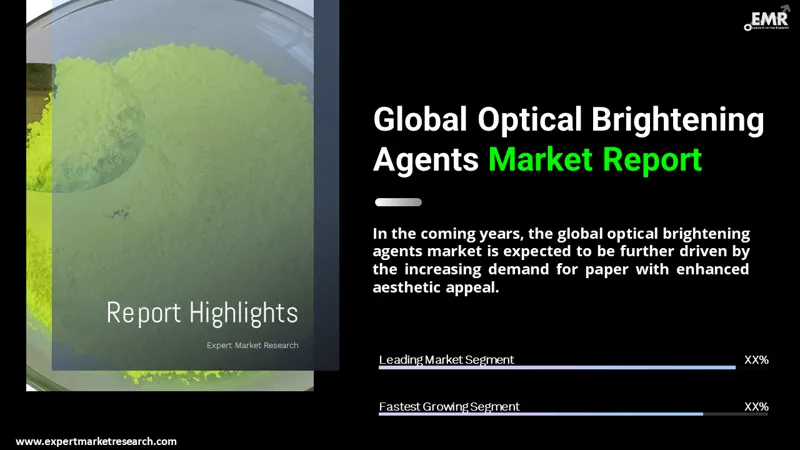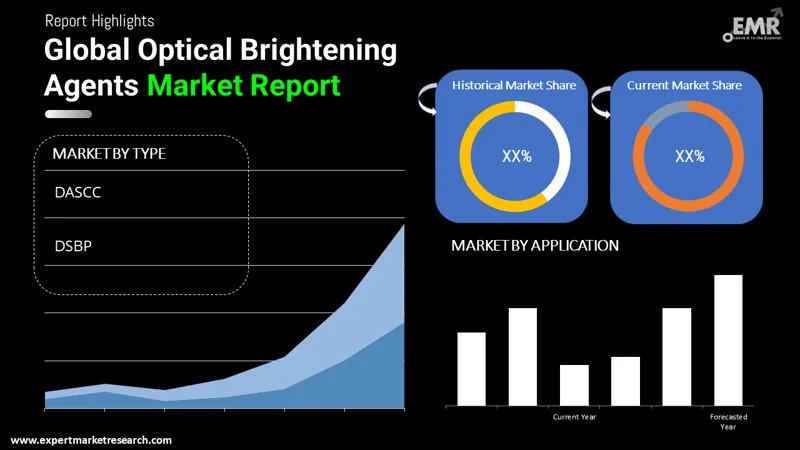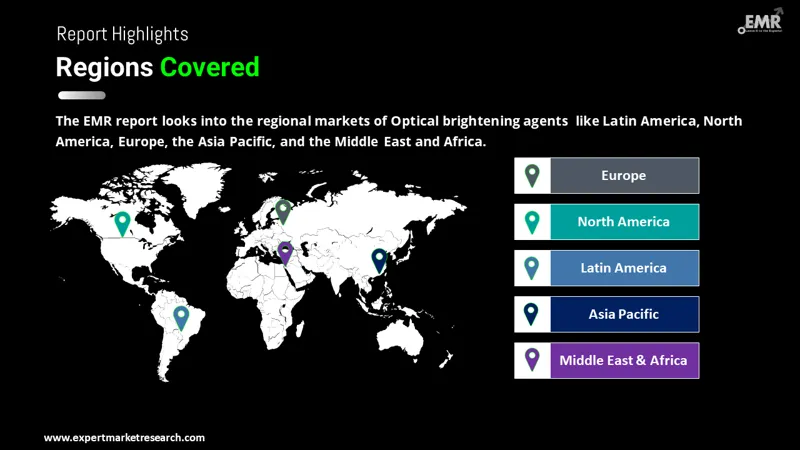
Consumer Insights
Uncover trends and behaviors shaping consumer choices today
Procurement Insights
Optimize your sourcing strategy with key market data
Industry Stats
Stay ahead with the latest trends and market analysis.
Trending Now



The global optical brightening agents market will likely experience a CAGR of about 5.40% during the period 2025-2034. A rise in demand for paper with greater aesthetic charm is anticipated to further drive the market in the years to come.
Base Year
Historical Period
Forecast Period






| Global Optical Brightening Agents Market Report Summary | Description | Value |
| Base Year | USD Billion | 2023 |
| Historical Period | USD Billion | 2018-2024 |
| Forecast Period | USD Billion | 2025-2034 |
| Market Size 2024 | USD Billion | XX |
| Market Size 2034 | USD Billion | XX |
| CAGR 2018-2024 | Percentage | XX% |
| CAGR 2025-2034 | Percentage | 5.4% |
| CAGR 2025-2034 - Market by Region | Asia Pacific | 6.2% |
| CAGR 2025-2034 - Market by Country | India | 7.1% |
| CAGR 2025-2034 - Market by Country | China | 6.0% |
| CAGR 2025-2034 - Market by Type | DASCC | 5.9% |
| CAGR 2025-2034 - Market by Application | Detergents | 6.1% |
| Market Share by Country 2023 | Germany | 4.6% |

Read more about this report - REQUEST FREE SAMPLE COPY IN PDF
Optical brightening agents, also known as fluorescent brightening agents, are chemicals employed in manufacturing plastics, fibres, coatings, inks and detergents. They absorb light in the ultraviolet and violet regions of the electromagnetic spectrum and give out light in the blue region. Further, greater acceptance of chemical optical brightening agents (based on coumarin, stilbene, cinnamic acid, diphenyl pyrazoline, dicarboxylic acid, etc.) in developing nations has been observed. Brightening agents are added to detergents to give clothes a cleaner appearance; ordinarily, cleaned clothes appear yellowish, which is not liked by consumers.
Rapid growth in textiles and cosmetics across the globe has driven the optical brightening agents demand growth. Introducing new optical brightening agents with better compatibility with recycled fibres is also expected to aid the recycled fibre industry.
Brightening agents are used in high-brightness paper to give it a strong, fluorescent appearance under ultraviolet light. Formerly, bluing was used for the same purpose but came to be replaced by modern optical brightening agents. Brighteners add to the detergent value and can also be used as fabric softeners. They are also used as bleaches. The detergent and cleaning sectors have been the key drivers of the optical brightening agents market.
The growth of the optical brightening agents industry is expanding due to rising demand in textiles, detergents, and paper industries. These agents enhance product appearance by making materials appear whiter and brighter. Technological advancements and increasing consumer awareness of product aesthetics drive market growth. Key regions witnessing significant market share include North America, Europe, and Asia-Pacific.
Factors that are responsible for opening up new optical brightening agents market opportunities include its increased use in textiles, biodegradable agents and engineering advances.
One of the growing uses of optical brightening agents is in the textile industry, where the trend is toward brighter and whiter fabrics. This trend has been fostered by consumers who desire more appealing and vibrant clothing, and industries that strive to improve their product performance.
Demand for eco-friendly, biodegradable agents is a rising trend of optical brightening agents market. With consumers and manufacturers increasingly focusing on sustainable products that will help reduce environmental impacts, innovation in greener formulation and cleaner process conditions is stimulated.
The demand for optical brightening agents is growing across emerging markets, especially in Asia-Pacific and Latin America. The need from this part of the world prevails due to rising disposable incomes and higher consumption of consumer goods, calling for effective brightening solutions.
The growth of the optical brightening agents market is aided by advances in chemical engineering that make way for the development of more efficient and multifunctional optical brightening agents. The innovations developed by various fields in terms of formulations with improved stability, effectiveness under different conditions, and compatibility with several products have been answering the diverse consumer and industrial needs.
As per optical brightening agents industry analysis, applications of optical brightening agents have extended to the security sector also. Bank notes and labels now have fluorescence to distinguish them from counterfeit notes. Only a small number of di- and tetra-sulfonated triazole-stilbenes, and one di-sulfonated stilbene-biphenyl derivative dominate the global optical brightening agent production for detergents, paper and textiles.
One of the growing trends in the optical brightening agents market is an increased demand for eco-friendly and biodegradable brighteners. With the "green" wave sweeping through consumers and manufacturers, this has driven the development and adoption of optical brighteners that have lower impacts on the environment. This forms part of a broader trend toward greener products, underpinned by regulatory pressure and consumer preference for environmental responsibility—ultimately augmenting the growth of optical brightening agents market.
Decreased demand due to allergic reactions when brightening agents come in direct contact with skin.

Read more about this report - REQUEST FREE SAMPLE COPY IN PDF
“Optical Brightening Agents Market Report and Forecast 2024-2032” offers a detailed analysis of the market based on the following segments:
By Type, the market can be segmented into:
By application, the market can be divided into:
By region, the market can be segregated into:
| CAGR 2025-2034 - Market by | Country |
| India | 7.1% |
| China | 6.0% |
| USA | 4.8% |
| France | 4.2% |
| Italy | 3.8% |
| Canada | XX% |
| UK | XX% |
| Germany | XX% |
| Japan | 3.7% |
| Australia | XX% |
| Saudi Arabia | XX% |
| Brazil | XX% |
| Mexico | XX% |
DASCC To Gain Traction For Its Superior Brightening Characteristics In Textiles
In the optical brightening agents market, the prospects of DASCC are expected to remain better than that of DABP. Better brightness and stability make DASCC effective in several applications, ranging from textiles to paper. Added properties in terms of performance and functional capabilities for a range of uses make it increasingly adopted requiring top-grade and long-lasting whitening.
One of the areas that increase the traction of DASCC when compared to DABP is high-performance textiles, where it can strongly improve its whiteness and brightness and hold that stability through many washes. For example, DACC can often be present in premium brands of sportswear or home textiles, like luxury bed linens or active sportswear where excellent brightening effects and durability are required. Such extensive implementation gives a competitive edge to DASCC over DABP in the market, thus supporting the optical brightening agents demand forecast.
Detergents Will Be The Dominant Application For Its Significant Usage In Cleaning Fabrics
The detergent industry is anticipated to be the largest consumer of optical brightening agents. The detergent industry is forecast to remain a significant consumer of optical brightening agents, as these chemicals, in effect, work on improving the fabrics themselves and give them a brighter and whiter look. In turn, optical brighteners absorb light at ultraviolet wavelengths and re-emit it at visible blue wavelengths, masking yellowing and dullness on clothes. This will improve the apparent cleanliness and brightness of laundry, which is a sell-out point of detergents and bolster the global optical brightening agents demand.
With consumers coming to demand more aesthetically pleasing and spotless clothing, the use of these brighteners in laundry products will grow vastly. This, in turn, will aid the changing optical brightening agents market dynamic and trends. Major detergent manufacturers will benefit from the introduction of new optical brightening agents, as these brightening agents can improve the brightness and whiteness of fabrics and hence make their products more attractive to consumers. This could differentiate brands, enable premium pricing, and build a competitive advantage.

Read more about this report - REQUEST FREE SAMPLE COPY IN PDF
Asia Pacific To Witness Moderate Demand Owing To Industrialisation And Robust Manufacturing Capabilities
Asia Pacific is expected to experience robust growth at a CAGR of nearly 5%. Nations such as China and India should drive the market owing to rapid industrialization, growing manufacturing activities, and a rising population with a demand for higher standards of living. Rising demand of optical brightening agents from consumers in India and China for brighter, whiter products is steering increased growth in the textile and paper industries as well. Another factor attributed to the higher demand for optical brightening agents is the increase in production capacities, industrial expansion, and improvement in living standards.
While the Middle East and Africa, and Latin America are anticipated to witness significant growth, markets in Europe and North America should see slow growth. Saturation of the paper industry in Europe and North America has caused paper mill shutdowns over the years, but the soaps and detergent sector should contribute to the overall drive the optical brightening agents market revenue.
Key players are focussing on innovations in eco-friendly agents and advanced manufacturing techniques to further boost market dynamics. This also promises significant opportunities through 2032.
Huntsman Corporation, located in The Woodlands, Texas, USA, and founded in 1970, produces its optical brightening agents under the brand Huntsman OBAs. These are UV-absorbing, blue-emitting products that enhance the brightness and whiteness value of detergents, textile, and paper to bring their aesthetic appeal to the fore.
BASF SE, headquartered in Ludwigshafen am Rhein, Germany, is an 1865 incorporation whose major offerings are optical brightening agents, like Tinopal and Lumalite, for numerous applications such as laundry detergents, paper, and textiles, to make them look whiter and brighter. BASF has focused on high-performance, eco-friendly formulae with reflecting blue light, to give products a cleaner and more radiant appearance.
Clariant International Ltd., headquartered in Muttenz, Switzerland, was established in 1995. Under the brand name Hostalux, it manufactures a full range of optical brightening agents, which are used to enhance brightness and whiteness in detergents, textiles, and paper. These agents of Clariant absorb UV light and then re-emit it as visible blue light, which enhances the appearance of cleaned fabrics and surfaces.
*Please note that this is only a partial list; the complete list of key players is available in the full report. Additionally, the list of key players can be customized to better suit your needs.*
Other market players include Evonik Industries AG and Tsaker Chemical Group Ltd., among others.
Australia Trade Finance Market
Warehousing and Storage Market
Optical Brightening Agents Market Size
Optical Brightening Agents Market Growth
Optical Brightening Agents Market Trends
Optical Brightening Agents Market Share
*While we strive to always give you current and accurate information, the numbers depicted on the website are indicative and may differ from the actual numbers in the main report. At Expert Market Research, we aim to bring you the latest insights and trends in the market. Using our analyses and forecasts, stakeholders can understand the market dynamics, navigate challenges, and capitalize on opportunities to make data-driven strategic decisions.*
Get in touch with us for a customized solution tailored to your unique requirements and save upto 35%!
The global optical brightening agents market is likely to expand at a CAGR of 5.40% during the forecast period of 2025-2034.
The major drivers of the industry include the rapid growth of textiles and cosmetics industries, growing recycled fibre industry, and the introduction of new optical brightening agents with better compatibility with recycled fibres.
The rising demand for paper with greater aesthetic charm is expected to drive the global optical brightening agents market further in the coming years.
The major regions in the industry are North America, Europe, the Asia Pacific, Latin America, and the Middle East and Africa.
The leading types of optical brightening agents in the industry are DASCC and DSBP.
The major application segments in the industry are paper, detergents, and textiles, among others.
The key players in the industry are Huntsman Corporation, BASF SE, Clariant, Evonik Industries AG, and Tsaker Chemical Group Ltd., among others.
Explore our key highlights of the report and gain a concise overview of key findings, trends, and actionable insights that will empower your strategic decisions.
| REPORT FEATURES | DETAILS |
| Base Year | 2024 |
| Historical Period | 2018-2024 |
| Forecast Period | 2025-2034 |
| Scope of the Report |
Historical and Forecast Trends, Industry Drivers and Constraints, Historical and Forecast Market Analysis by Segment:
|
| Breakup by Type |
|
| Breakup by Application |
|
| Breakup by Region |
|
| Market Dynamics |
|
| Competitive Landscape |
|
| Companies Covered |
|
| Report Price and Purchase Option | Explore our purchase options that are best suited to your resources and industry needs. |
| Delivery Format | Delivered as an attached PDF and Excel through email, with an option of receiving an editable PPT, according to the purchase option. |
Datasheet
One User
USD 2,499
USD 2,249
tax inclusive*
Single User License
One User
USD 3,999
USD 3,599
tax inclusive*
Five User License
Five User
USD 4,999
USD 4,249
tax inclusive*
Corporate License
Unlimited Users
USD 5,999
USD 5,099
tax inclusive*
*Please note that the prices mentioned below are starting prices for each bundle type. Kindly contact our team for further details.*
Flash Bundle
Small Business Bundle
Growth Bundle
Enterprise Bundle
*Please note that the prices mentioned below are starting prices for each bundle type. Kindly contact our team for further details.*
Flash Bundle
Number of Reports: 3
20%
tax inclusive*
Small Business Bundle
Number of Reports: 5
25%
tax inclusive*
Growth Bundle
Number of Reports: 8
30%
tax inclusive*
Enterprise Bundle
Number of Reports: 10
35%
tax inclusive*
How To Order
Our step-by-step guide will help you select, purchase, and access your reports swiftly, ensuring you get the information that drives your decisions, right when you need it.

Select License Type
Choose the right license for your needs and access rights.

Click on ‘Buy Now’
Add the report to your cart with one click and proceed to register.

Select Mode of Payment
Choose a payment option for a secure checkout. You will be redirected accordingly.
Track prices with detailed trend reports.

Analyse trade data for supply chain insights.

Leverage cost reports for smart savings

Enhance supply chain with partnerships.

Gain insights to stay ahead and seize opportunities.

Get insights & trends for a competitive edge.

Track prices with detailed trend reports.

Analyse trade data for supply chain insights.

Leverage cost reports for smart savings

Enhance supply chain with partnerships.

Gain insights to stay ahead and seize opportunities.

Get insights & trends for a competitive edge.

Track prices with detailed trend reports.

Analyse trade data for supply chain insights.

Connect For More Information
Our expert team of analysts will offer full support and resolve any queries regarding the report, before and after the purchase.
Our expert team of analysts will offer full support and resolve any queries regarding the report, before and after the purchase.
We employ meticulous research methods, blending advanced analytics and expert insights to deliver accurate, actionable industry intelligence, staying ahead of competitors.
Our skilled analysts offer unparalleled competitive advantage with detailed insights on current and emerging markets, ensuring your strategic edge.
We offer an in-depth yet simplified presentation of industry insights and analysis to meet your specific requirements effectively.



Australia
63 Fiona Drive, Tamworth, NSW
+61-448-061-727
India
C130 Sector 2 Noida, Uttar Pradesh 201301
+91-723-689-1189
Philippines
40th Floor, PBCom Tower, 6795 Ayala Avenue Cor V.A Rufino St. Makati City,1226.
+63-287-899-028, +63-967-048-3306
United Kingdom
6 Gardner Place, Becketts Close, Feltham TW14 0BX, Greater London
+44-753-713-2163
United States
30 North Gould Street, Sheridan, WY 82801
+1-415-325-5166
Vietnam
193/26/4 St.no.6, Ward Binh Hung Hoa, Binh Tan District, Ho Chi Minh City
+84-865-399-124
United States (Head Office)
30 North Gould Street, Sheridan, WY 82801
+1-415-325-5166
Australia
63 Fiona Drive, Tamworth, NSW
+61-448-061-727
India
C130 Sector 2 Noida, Uttar Pradesh 201301
+91-723-689-1189
Philippines
40th Floor, PBCom Tower, 6795 Ayala Avenue Cor V.A Rufino St. Makati City, 1226.
+63-287-899-028, +63-967-048-3306
United Kingdom
6 Gardner Place, Becketts Close, Feltham TW14 0BX, Greater London
+44-753-713-2163
Vietnam
193/26/4 St.no.6, Ward Binh Hung Hoa, Binh Tan District, Ho Chi Minh City
+84-865-399-124
Share